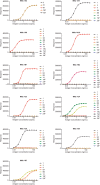Human monoclonal antibodies isolated from a primary pneumococcal conjugate Vaccinee demonstrates the expansion of an antigen-driven Hypermutated memory B cell response
- PMID: 30509199
- PMCID: PMC6278343
- DOI: 10.1186/s12879-018-3517-7
Human monoclonal antibodies isolated from a primary pneumococcal conjugate Vaccinee demonstrates the expansion of an antigen-driven Hypermutated memory B cell response
Abstract
Background: Community-acquired pneumonia is a leading infectious cause of hospitalization. A few vaccines exist to prevent pneumococcal disease in adults, including a pneumococcal polysaccharide unconjugated vaccine and a protein conjugated polysaccharide vaccine. Previous studies on the human immune response to the unconjugated vaccine showed that the vaccine boosted the existing memory B cells. In the present study, we investigated the human B cell immune response following pneumococcal polysaccharide conjugate vaccination.
Methods: Plasmablast B cells from a pneumococcal polysaccharide conjugate vaccinee were isolated and cloned for analysis. In response to primary vaccination, identical sequences from the plasmablast-derived antibodies were identified from multiple B cells, demonstrating evidence of clonal expansion. We evaluated the binding specificity of these human monoclonal antibodies in immunoassays, and tested there in vitro function in a multiplexed opsonophagocytic assay (MOPA). To characterize the plasmablast B cell response to the pneumococcal conjugated vaccine, the germline usage and the variable region somatic hypermutations on these antibodies were analyzed. Furthermore, a serotype 4 polysaccharide-specific antibody was tested in an animal challenge study to explore the in vivo functional activity.
Results: The data suggests that the pneumococcal polysaccharide conjugate vaccine boosted memory B cell responses, likely derived from previous pneumococcal exposure. The majority of the plasmablast-derived antibodies contained higher numbers of variable region somatic hypermutations and evidence for selection, as demonstrated by replacement to silent ratio's (R/S) greater than 2.9 in the complementarity-determining regions (CDRs). In addition, we found that VH3/JH4 was the predominant germline sequence used in these polysaccharide-specific B cells. All of the tested antibodies demonstrated narrow polysaccharide specificity in ELISA binding, and demonstrated functional opsonophagocytic killing (OPK) activity in the MOPA assay. The in-vivo animal challenge study showed that the tested serotype 4 polysaccharide-specific antibody demonstrated a potent protective effect when administered prior to bacterial challenge.
Conclusions: The findings on the pneumococcal polysaccharide conjugate vaccine responses from a vaccinated subject reported in this study are similar to previously published data on the pneumococcal polysaccharide unconjugated vaccine responses. In both vaccine regimens, the pre-existing human memory B cells were expanded after vaccination with preferential use of the germline VH3/JH4 genes.
Keywords: Human; Monoclonal antibodies; Plasmablast B cell; Pneumococcal conjugate vaccine.
Conflict of interest statement
Ethics approval and consent to participate
All animal experiments were approved by the Institutional Animal Care and Use Committee (IACUC), Merck & Co., Inc. (Kenilworth, NJ, USA). All procedures were performed in accordance with our institution’s IACUC guidelines in strict accordance with the recommendations in the Guide for Care and Use of Laboratory Animals of the National Institutes of Health.
The human donor was provided with written informed consent from the blood bank (Biological Specialties, Inc.), and the Merck Institutional Review Board approved the human study.
Consent for publication
The manuscript had been approved for publication.
Competing interests
All the authors are salaried Merck employee, and this fact does not affect the objectivity and integrity of this manuscript.
Publisher’s Note
Springer Nature remains neutral with regard to jurisdictional claims in published maps and institutional affiliations.
Figures


Similar articles
-
Immunogenetic analysis of the immune response to pneumococcal polysaccharide.Eur J Immunol. 2000 Apr;30(4):1214-23. doi: 10.1002/(SICI)1521-4141(200004)30:4<1214::AID-IMMU1214>3.0.CO;2-D. Eur J Immunol. 2000. PMID: 10760811
-
Isolation and Characterization of Human Monoclonal Antibodies to Pneumococcal Capsular Polysaccharide 3.Microbiol Spectr. 2021 Dec 22;9(3):e0144621. doi: 10.1128/Spectrum.01446-21. Epub 2021 Nov 10. Microbiol Spectr. 2021. PMID: 34756090 Free PMC article.
-
Effect of previous vaccination with pneumococcal conjugate vaccine on pneumococcal polysaccharide vaccine antibody responses.Clin Exp Immunol. 2016 Aug;185(2):180-9. doi: 10.1111/cei.12784. Epub 2016 May 20. Clin Exp Immunol. 2016. PMID: 26939935 Free PMC article.
-
Experience with pneumococcal polysaccharide conjugate vaccine (conjugated to CRM197 carrier protein) in children and adults.Clin Microbiol Infect. 2013 Oct;19 Suppl 1:1-9. doi: 10.1111/1469-0691.12320. Clin Microbiol Infect. 2013. PMID: 24083785 Review.
-
Immunogenicity differences of a 15-valent pneumococcal polysaccharide conjugate vaccine (PCV15) based on vaccine dose, route of immunization and mouse strain.Vaccine. 2017 Feb 7;35(6):865-872. doi: 10.1016/j.vaccine.2016.12.055. Epub 2017 Jan 10. Vaccine. 2017. PMID: 28087148 Review.
Cited by
-
Increasing human monoclonal antibody cloning efficiency with a whole-cell modified immunoglobulin-capture assay (mICA).Front Immunol. 2023 Jun 2;14:1184510. doi: 10.3389/fimmu.2023.1184510. eCollection 2023. Front Immunol. 2023. PMID: 37334357 Free PMC article.
-
Broadly Reactive Human Monoclonal Antibodies Targeting the Pneumococcal Histidine Triad Protein Protect against Fatal Pneumococcal Infection.Infect Immun. 2021 Apr 16;89(5):e00747-20. doi: 10.1128/IAI.00747-20. Print 2021 Apr 16. Infect Immun. 2021. PMID: 33649050 Free PMC article.
-
Identification and Quantification of a Pneumococcal Cell Wall Polysaccharide by Antibody-Enhanced Chromatography Assay.Vaccines (Basel). 2024 Apr 28;12(5):469. doi: 10.3390/vaccines12050469. Vaccines (Basel). 2024. PMID: 38793720 Free PMC article.
-
No Waning of Pneumococcal Vaccine Responses over Time in People with Inflammatory Arthritis: Findings from a Single Centre Cohort.Vaccines (Basel). 2024 Jan 10;12(1):69. doi: 10.3390/vaccines12010069. Vaccines (Basel). 2024. PMID: 38250882 Free PMC article.
-
Salmonella Typhi Vi capsule prime-boost vaccination induces convergent and functional antibody responses.Sci Immunol. 2021 Oct 29;6(64):eabj1181. doi: 10.1126/sciimmunol.abj1181. Epub 2021 Oct 29. Sci Immunol. 2021. PMID: 34714686 Free PMC article.
References
MeSH terms
Substances
LinkOut - more resources
Full Text Sources
Medical

